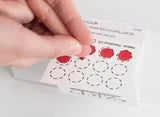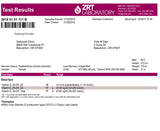Vitamin D 25-oh total (Testing Vitamin D2 & D3) is for testing Vitamin D2 & D3 In Dried Blood Spots.
Detects deficiencies in Vitamin D (independently monitoring both Vitamin D2 and D3 status by LC-MS/MS) as a potential cause of health problems ranging from osteoporosis to cardiovascular disease.
Most people are familiar with vitamin D’s role in preventing rickets in children and helping the body absorb calcium from the diet.
Test Result: You will receive your test result 3-5 working days after the laboratory receives your sample. You will see your hormone levels in graphics and numbers on your test results. You will also see laboratory comments by Hormone Specialist PhD Dr in the comments: you will find an analysis of your hormone levels and what to do next.
- Collect samples from the comfort of your home and post them to our lab.
- The test must be used within 12 months after the purchase date.
- The test kit includes a laboratory fee: no additional laboratory cost or tax.
- Customers are responsible for shipping their samples to the laboratory.
Recently, research has shown that vitamin D is important in protecting the body from a wide range of diseases. Disorders linked with vitamin D deficiency include:
- Stroke,
- Flu,
- Cardiovascular disease,
- Osteoporosis,
- Osteomalacia,
- Several forms of cancer,
- Some autoimmune diseases, such as multiple Sclerosis,
- Rheumatoid Arthritis,
- Type I Diabetes & Type II Diabetes,
- Breast and Colon Cancer (linked to Vitamin D Deficiency),
- Depression and even schizophrenia.
Vitamin D is actually a prohormone and not technically a vitamin: a vitamin is defined as a substance that is not made naturally by the body but must be supplied in the diet to maintain life processes. But in fact, we make most of our vitamin D by the action of ultraviolet light (sunlight) on the vitamin D originator found in our skin. As a result, we only get very small amounts of vitamin D from our diet, although increasingly, it is added to foods eaten by children to prevent rickets in the population.
Cause of Vitamin D Deficiency
A major cause of vitamin D deficiency is not getting enough sun.
This happens because people don’t spend much time outdoors. Women, in particular, often have much of their skin area covered for cultural reasons. The use of sunscreen also blocks the formation of vitamin D in the skin.
Why Vitamin D Deficiency Test?
Testing for vitamin D is an important screening test, especially if you spend much of your time indoors or live in a colder climate. This blood spot test measures both the natural form of Vitamin D (D3) and D2, the form used in many supplements. So, testing can be used to monitor vitamin D supplementation to ensure you are getting the right amount for optimum health.
Who is at Risk?
The Elderly
Amounts of the vitamin D originator in the skin decrease with age; therefore, older people are particularly prone to deficiency, and living in rest homes or becoming home-bound can limit exposure to sunshine. In addition, muscle weakness and osteoporosis associated with vitamin D deficiency make the elderly more susceptible to falling and fracture risk, and studies show that vitamin D supplementation may decrease the risk of fractures.
Dark-Skinned People
Because people with darker skin have higher levels of melanin, which can block the action of sunlight on vitamin D originators, they may require much longer exposure to sunlight than people who are fair-skinned.
People with Limited Sunlight Exposure
People living in northern latitudes or with limited sunlight exposure because of their working environment or cultural dress rules may have low vitamin D levels.
Musculoskeletal Pain Sufferers
People with hypothyroidism, non-specific musculoskeletal pain, chronic low back pain, or fibromyalgia symptoms frequently have low vitamin D levels. However, after supplementation, the improvement has been shown during clinical research. Therefore, vitamin D screening is strongly recommended in muscle and joint pain patients.
Overweight or Obese People
Vitamin D can be locked up in the fat stores of obese people, who have been found to have lower levels of circulating vitamin D and are at risk of deficiency.
Breast-fed infants and Children with Limited Sunlight Exposure
All children require adequate circulating vitamin D to prevent rickets. Dark-skinned children and those who spend much of the day inside daycare centres are at risk of deficiency, and breastfed children often receive inadequate amounts of vitamin D, mainly when their mothers are deficient. Giving vitamin D supplements to the nursing mother or the use of cod liver oil or other vitamin D supplements in infants and children can reduce the risk of developing type I diabetes in childhood.
Vitamin D screening has been recommended as a routine part of the annual physical examination. Deficiency does not have obvious symptoms but increases your risk for more serious diseases.
Clinical Utility
Blood spot testing for Vitamin D can help your doctor:
• Identify vitamin D deficiency as a potential cause of health problems – levels below 20 ng/mL indicate a deficiency, while levels below 32 ng/mL are “low”; optimal levels are 32-100 ng/mL (research is ongoing to establish definitive recommendations)
• Recommend the right dose of vitamin D as a supplement and monitor your D levels during
Supplementation to ensure you have adequate levels without overdosing – toxicity may be expected at levels >150 ng/mL
• Recommend appropriate ways to safely increase sunlight exposure and modify your diet to include more vitamin D-containing foods and supplements
• Track treatment progress with follow-up testing
How is the test carried out?
This blood spot-based testing tool can be done in the privacy of your home. A simple step of collecting your blood spot for the test is required. Once you provide a blood spot, you must seal the sample and send it to us. Your test result report will be emailed to you between 3 and 5 working days after the laboratory receives your sample.
How to Use


















